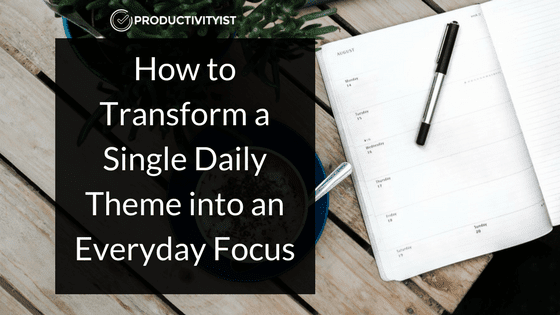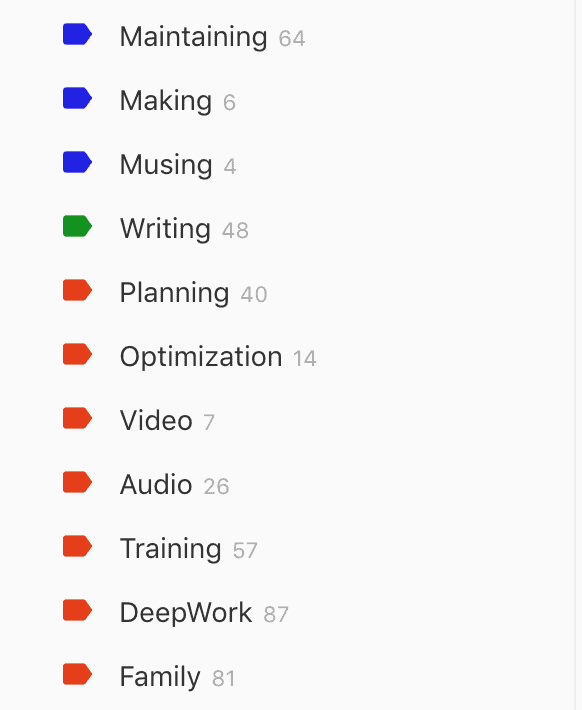 Administrative tasks are the bane of my existence.
Administrative tasks are the bane of my existence.
I classify administrative tasks as those that require more of “maintenance mindset” than anything else. While these tasks don’t move me forward in leaps or bounds, not doing them can hinder progress on other tasks that lead to greater gains.
Ever since I started theming my days I’ve set aside one day of the week to focus on administrative tasks. I figured that by dedicating a day to them I could get into a state of flow and be more productive. My goal was to deal with these tasks and get them out of the way so I could focus on other work like writing, recording audio content, diving into deep work, learning new skills, and so on.
However, when I returned from two conferences in San Diego – Traffic and Conversion and Social Media Marketing World – I found myself reevaluating the concept of giving a whole day to these types of tasks.
A Change Was Needed
Both of these conferences focused on marketing in some way, shape, or form. There were definitely some crossover takeaways from them, most notably the following:
1. Video content and marketing is more important than ever
2. Chatbots and Live message automation is worth exploring
3. Don’t put all your eggs in the Facebook advertising basket
The first takeaway started an internal dialogue around my Daily Themes. One of my days had been focused on administrative work. Another day was dedicated to doing audio and video work. Since video is something I want to invest more time, energy, and attention on, it can no longer share a day with audio work.
My first decision was to make Wednesday’s theme one that placed a focus on any and all audio work. Once I made that call, I immediately leveraged the newly-found space by creating a daily podcast called Three Minutes of TimeCrafting. I’ve been able to dive even deeper into existing audio tasks that have been shelved for a while.
Next, I had to find a home for a new Daily Theme: Video.
Finding a Day for a Fresh Daily Theme
Here was what my Daily Themes looked like before making the shift:
Sunday: Planning
Monday: Optimization
Tuesday: Administrative
Wednesday: Audio/Video
Thursday: Training
Friday: Deep Work
Saturday: Family
It was pretty safe to keep Wednesday as my Audio Day because all of my upcoming podcast interviews were scheduled in advance for weeks to come. I didn’t want to choose Sunday, Monday, Friday, or Saturday for video work because it would be possible or likely that members of my family would be home on those days. That left Tuesday and Thursday as the remaining options. I’ve reserved Thursday for training – meaning training others and myself in new skills – for as long as I can remember, and I have some standing coaching appointments on Thursday as well. I felt as if altering it to put video in its place would be no different than me trying to do the same on Wednesdays. It just didn’t make sense. It would cause friction in more ways than it wouldn’t.
So I decided that Tuesday was going to be my new Video Day.
Choosing Tuesdays really makes the most sense. It had all the qualities I was looking for when it came to working video content.
1. Tuesday is a quiet day. My wife Anne would be around for part of the day, but the kids would never be home unless it was an extended holiday break or they were ill. I could get at least 4 hours of footage filmed without distraction or disruption.
2. Tuesday is early in the week. I can film on Tuesdays and begin post-production to have a weekly video posted on YouTube by Friday. I am able to do Facebook Live shows on that day and can incorporate them into the weekly digest email I send out every Thursday known as The Dailies.
3. I want to optimize how I handle administrative tasks. Giving them a single day wasn’t working any longer. It wasn’t reasonable for me to only handle those types of tasks once per week. I also found that Tuesdays are my least productive days. When using my ZEI° (made by the folks at Timeular), I found that most of my short entries were on Tuesdays while my longer entries were on Wednesdays, Thursdays, and Fridays. I think that has a direct correlation to how often I was switching tasks and task modalities on my now-defunct Administrative Day.
Finding Days for a Former Daily Theme
Even though administrative tasks are the bane of my existence, I recognize they need to be dealt with regularly. Since I determined that having them fall under a single Daily Theme wasn’t working, I needed to come with a way to make sure they still had my attention throughout the week. So I decided to take stock of other types of tasks that needed to be done consistently as well so I could try to craft them as Horizontal Themes going forward.
In order to properly do this, I decided to look at The 5 Categories of Mode-Based Work that are an integral part of my TimeCrafting methodology. If you’re unfamiliar with these categories, they are:
- Theme-Based Modes
- Resource-Based Modes
- Energy-Based Modes
- Activity-Based Modes
- Time-Based Modes
I recognized that the last category, Time-Based Modes, wouldn’t work in this strategy because it is best used either within existing Horizontal Themes or Daily Themes. A Resource-Based Mode wouldn’t work either because it is too narrow in scope. So I was left with Theme-Based Modes, Energy-Based Modes, and Activity-Based Modes.
At this point I reviewed Todoist to see what types of tasks were labeled with the Administrative label. I suspected many of them would be tasks that were easy to do and require less depth of focus than any of the other tasks I had in the app.
I was right.
In fact, one of my coaching clients and I had discussed the idea of “maintenance” as a label for tasks that were essential to keep things going but didn’t involve deep focus or even great effort. They were, by definition, tasks you needed to do to simply maintain things.
With that, I created a Horizontal Theme called Maintenance (which I changed to Maintaining after choosing the next two themes. You’ll know why once I reveal them to you.)
Each morning I allocated the 9-10am time slot to tasks that fall into the Maintaining theme. Why? My energy level is lower in the morning due to me being a night owl – or “wolf” as suggested by Dr. Michael Breus in his book The Power of When. Ideally, I should be doing lower energy tasks before lunch, and I used Dr. Breus’s ideal day for my chronotype to guide me with that decision.
That time slot is set aside for maintenance tasks every day of the week so I wind up with at least 7 hours of that type of work scheduled. That horizontal theme replaces the full day of administrative tasks that I once had assigned to Tuesdays and because I’ve given myself a tighter timeline to finish them in (one hour per day as opposed to all of one day), less time will be wasted overall.
I also noticed that I wasn’t spending as much time writing in the later hours of the day any longer. I’m still very much a night owl, but I find that much of what I do late at night is mapping things out and reflecting as opposed to writing or creating anything. That’s when I decided to create a horizontal theme for writing earlier in the day throughout the week. I wanted a time slot where I could focus on creating things and based on my chronotype the best time of day for me to focus on deeper work was from 2-4pm. So that two hour block of time is now called Making Mode time.

Each day of the week I’ll focus on making stuff during those hours. This includes all types of writing or anything else that requires me making something. I’ve gone as far as to ensure that no one can schedule anything with me during those hours by adjusting my schedule to open up more hours later in the day on Mondays and Thursdays.
As for the old horizontal theme where I did focus on writing – scheduled from 10pm-1am everyday – that is when I go into Musing Mode. I’ve adjusted that time period from 10pm-12am, and during that time I’ll focus on planning, brainstorming, journaling, meditating, and finishing up my evening routine for the day. I’ve found that I’m better suited to do that sort of thing during those hours rather than write, so allocating that time for “musing” activities makes the most sense going forward.
As you can see, I ultimately used elements of all three remaining categories of mode-based work when setting up these three new Horizontal Themes.
- Theme-Based Modes: Whenever I make something, it’s a form of deep work. Planning is a form of deep work but has elements of musing in it as well. Maintaining (by my definition) involves many of my administrative tasks. All three of those (administrative, deep work, and planning) either were or still are my Daily Themes.
- Energy-Based Modes: I used my chronotype to help decide where my Horizontal Themes should be placed. My energy levels throughout the day played a role in that. I’m better at lower energy tasks in the morning, meaning that doing any kind of maintaining would be ideal earlier in the day. The later hours of the day are better for deeper creative work and reflection so I chose time slots that would work best for me for making and musing based on that understanding.
- Activity-Based Modes: The simplest definition of this type of mode is anything ending in “ing” and all of my new Horizontal Themes fit that definition. In fact, I intentionally changed “maintenance” to “maintaining” to match up with the other two new themes to drive that point home.
These new Horizontal Themes override the Daily Themes, so no matter what the Daily Theme is, I’m going to be in Maintaining Mode from 9am to 10am every morning. When you have Horizontal Themes, you can feel less restricted about when you can do certain types of tasks. I know that some people can’t do administrative work only one day of the week; I couldn’t keep that up either.
Rather than tossing out all of my Daily Themes because one wouldn’t work, I added a horizontal theme to the mix to accomplish what I needed. This Horizontal Theme gives me time spread out over the course of the week for certain types of tasks.
So, how did I transform a Daily Theme into an everyday focus?
I now focus on Video on Tuesday (single Daily Theme) but can also make videos between 2 and 4 pm (everyday focus). I may not have a day dedicated to administrative work any longer (single Daily Theme), but I do have one per day that I’ve chosen to work on those sort of tasks (everyday focus). The same goes for Deep Work (deep work = making) and Planning (planning = musing).
Daily Themes on their own won’t work for everyone because you need to work on certain types of tasks throughout the week. Horizontal Themes on their own won’t work for everyone because having an emphasis or focus for each day lowers decision fatigue and keeps you moving things forward. But using both types of themes in tandem can enable you to deal with you need to do and ultimately do more of what you want to do every single day.

